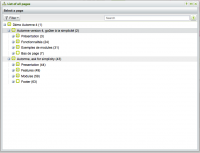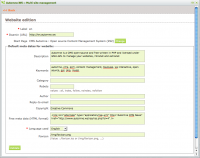Websites management
Définition
Multisite management allows you to manage several websites, each with their own domain, with one Automne and thus only one hosting.
In order to function correctly all the domains managed by Automne must be directed to the IP of the host server. More information about the IP and hosting
This option is often used when you want a site in several languages.
Your configuration may look like this :
- monsite.fr : your French site
- monsite.com : your English site
- monsite.es : your Spanish site
In order to understand how multisites work, one must first imagine the site in the form of a tree (sitemap).
From the installation of Automne, your sitemap has a unique root: identifier 1. This root is naturally a redirection towards a sub-page, which is the homepage of your site.
A simple example
From your root page (identifier 1), we will create a site in French (FR). The site will be made up of 3 pages:
- a home page (ID 2)
- a "Sales" page (ID 3)
- a "Contact" page (ID 4)

Multilingual site management : original French version
These pages are in French and correspond to the first site at which visitors arrive. This is the first in the list of site sites under Automne.
Note that page 1 has a redirection to page 2. Nevertheless, with multisite management this redirection is not used. The redirections defined in the site management interface are managed directly in the index.php file, thus even before arriving at page 1.
In order to add the English site, its root page must be created (just as page 2 is the root of the French site) thus putting under this page the pages of the English site.

Multilingual site management : english version added
The English site is now made up of pages 5, 6 and 7 and the address mysite.com redirects to page 5.
Our sitemap looks like the following example:

The site configuration looks like the following:

In the case where two sites are configured with the same domain, the first in the list will be displayed for the domain. It is possible to change the order of sites by dragging and dropping.
Like the English site, the Spanish site can be placed at any level of the tree in order to make it a root. It is possible, for example (but not recommended), to begin the Spanish site on page 5, which would become a page on the Spanish site and no longer a page on the English site.
For the rest of the example the Spanish site will have page 8 for a root, which will always be created under root 1.

Multilingual site management : spanish version added
There are thus now three root sites: 2, 5 and 8
It is important to note that by default, sites only recognize their tree. Even if the Spanish site is below page 5, for example, it will not be aware that it is below the English site. The Spanish site, thus defined in the site management interface, begins at page 8 (root), no matter where this page is situated in the overall tree. For this reason it is not possible to use a relative type atm-linx to access a page outside of the current site
To bypass this restriction it is nonetheless possible to activate the crosswebsite parameter..
The limitation of a relative atm-linx is not applied to a direct link, thus it is possible to link a page outside of the current site if the identifier (ID) is known.
To facilitate site management it is possible to associate the pages templateswith one or more sites with which they can be used exclusively. This allows you to partition the styles of your sites and prevents editors from overstepping their rights.
Administration
Multisite management is done on the “Site Management” window in the administration sidepanel tab
In this window all the sites managed by Automne are listed and the most important information for each one is displayed.
Remember that the order of sites displayed is crucial because it determines which site will be displayed in the case where several sites share the same domain.
When a site is created you will first be asked to choose a root for your new site. This choice cannot be modified afterwards, so where your new site begins should be chosen carefully.
By default at the installation of Automne, you have a principal site whose root is page 1. It is not possible to modify this root. Logically, Automne needs at least 1 principal site to function. It is, however, possible to modify the root of your other sites from the site management interface.
It is not possible to define 2 sites that point to the same root page. You can nevertheless redirect your second site to another Automne page which redirects to the desired page.
Remember that the sites are virtual; in no case will they delete the data on your site. Yet changes must be made with caution because their impact on pages is not negligible:
- The site root permits Automne to calculate dynamic links
- The indicated language defines the default language of pages.
- The metadata are inserted by default for all pages.
Once at the chosen root you have a window for both the modification and creation of a site.

Here you can define:
- the label of your site; the label is an important value which will be used to construct the URLs of your site. Suppose that the domain of your site is mysite.es and that its label is site_es; all the URLs of your pages will begin with www.monsites.es/site_es/. The label of a site is not modifiable so it is important to choose it well,
- the domain of your site (the address where it will be available),
The default metadata for your site. This information will be added in the meta of your site’s pages (at least if you do not otherwise define said pages) and will be useful for navigators and search engines.
The metadata are optional with the exception of the language, which Automne uses to choose the text to display to visitors and thus easily manage a multilingual site.
Metadata in détail :
- Description : used to briefly describe site content, this information is often displayed by engines under the address resulting from the search
- Keywords : keywords indicate the themes of the site for search engines, although they are used less and less.
- Category : indicates the category to which your site belongs
- Robots : defines the behavior you want from search engines. This option, for example, can request that content is not indexed by a search engine.
- Author : defines the author of the site.
- Response Email : defines the email address of the site manager; it is important to know that by supplying this information you make the address public and expose it to the risk of unwanted emails.
- Copyright : defines the copyright of your site.
- Free metadata : allows you to define your own meta fields with the form <meta name= "NAME" content= "VALUE" />
- Language used : defines the language of the site and helps Automne choose the text to display to visitors (for example the text of the Forms module).
- Favicon : defines the favorites icon (favicon) for your site.
You can delete all sites except the principle site. This is irreversible, so be certain before deleting a site.
If you delete a site in error, it is always possible to recreate an identical one.
Site regeneration
All modification of a site from the site management interface leads to the regeneration of impacted sites.
If necessary, Automne automatically regenerates the index file of your website: this is the file that detects the domain name and redirects to the correct site.
/index.php
After modifying a site, it is possible that the desired redirection will not be immediately visible; Automne deals with page regeneration in a queue.
The /index.php file is modified automatically while you manually regenerate a branch or the root of a site.






 French
French
Add a contribution